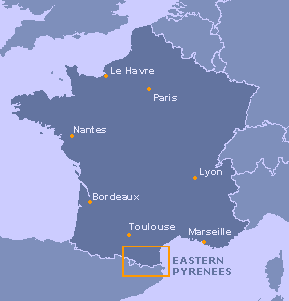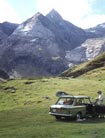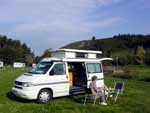|
|
PYRENEES REVISITED - Week 2 News |
||
|
The
foothills of Roussillon provide a perfect hors d'oeuvre to the high
Pyrenean mountains. With craggy limestone gorges and valley bottoms rich
in vines, the area is steeped in history, the tangible remains of which
are still visible today in its many medieval castles. South of Carcassonne and along the
river Aude, we
crossed into the Fenouillèdes
valley; we had planned to spend a couple of days and finished up
staying almost a week. The area's name comes from fennel (fenouille) which grows locally, and is used as both vegetable and aromatic herb; braised to accompany escalopes of veal, or sliced raw in salad, fennel is delicious. Vines fill the valley floor. New year's growth on the woody vine-stocks of traditional local varieties (such as Carignan and Grenache) is pruned into goblet shaped bushes (taillé en gobelet); only the Syrah vines are strung out along wires as further north. We were well sustained during the week by the local vins de pays and AOC Côtes de Roussillon. The quality does however vary between producers. But it was the area's history which really drew our attention. From AD 1000 this troubled border area was divided into feudal fiefdoms with local nobles fortifying strongpoints to defend their territories against invasions from Aragon to the south. At the start of the 13th century, these castles offered safety to Cathar refugees; this persecuted sect with significant following in Languedoc enjoyed support from local powerful feudal lords. The Cathar religion, of unknown eastern origins, was based around the 'dualistic' tenet of Good (God supreme in a spiritual world of beauty and light) and Evil (the material world ruled by Satan) with humankind caught in the middle. Cathar (or Albigensian from the town of Albi where their presence was strongest) priests were entitled Bons Hommes and led an austere life based on ascetic ideals of poverty, chastity and humility - a stark contrast with the corrupt and dissolute Catholic clergy of the day. Seeing the Cathars as a threat to church authority, Pope Innocent III launched the Albigensian Crusade to suppress the Cathars by force. A huge army of out of work mercenaries was gathered, led by that renowned thug Simon de Montfort (if there was pillage and rape to be done, he was your man). This genocidal approach was aided and abetted by the King of France who stood to make territorial gains in Languedoc-Roussillon by sorting out rebellious feudal lords. The unfortunate Cathars were offered refuge in feudal castles like those in le Fenouillèdes. The persecutions continued over several decades, and where brute force failed, the Inquisition finished the job of ridding the Catholic church of such troublesome heretics. One by one, the Cathar castles were captured, despite their impregnable positions atop rocky outcrops, and subsequently garrisoned by the French Kingdom to defend the frontier with Spain. The politically inspired suppression of the Cathars represents a small but infamous part of the Castles' history, but earned the area the title of le Pays Cathare. We spent 2 excellent days visiting the remains of the Fenouillèdes castles of Queribus, Peyrepertuse and Puilaurens. Their history was fascinating, their setting breath-taking, and the military architecture in planting such structures on precipitous mountain tops was sheer audacity (Photo 2). Queribus was a maze of passage-ways, spiral staircases and fortifications, the centrepiece of which was a massive 2 storeyed donjon with highly impressive Gothic vaulting. At Peyrepertuse, the fortifications covered the entire length of an 800m high spur with craggy precipice on 3 sides. The 13th century royal fortress atop the outcrop's very pinnacle gave almost aerial views down onto the original 11th century feudal castle (Photo 3). From some distance on the steep approach road to Puilaurens, the well-preserved crenellated fortress walls perched on the exposed spur stand out in defiant splendour. This was the last Cathar castle to fall in 1256 in the final action of the Albigensian Crusade, afterwards becoming the French kingdom's most advanced strategic defence position against Spanish invasion. The weather in the Fenouillèdes remains bright as long as the local NW wind (la Tramontane) blows from over the mountains keeping the clouds moving down valley to the sea. But on Tuesday, the wind stopped, and the following day's local paper, the 'Independent Catalan', reported that 37mm of rain fell between 6-00am and 4-00pm. The headline ran: "15 cm de neige sur les hauteurs - journée blanche hier en Cerdagne et Capcir où la neige est tombée en abondance". And Cerdagne et Capcir was just where we were heading next! We followed the winding road up the gorges of the Aude valley then climbed in endless sweeping curves up onto alpine plateau country. Here we overnighted at Camping la Devèze in a superb position at 1600m in pine forests just outside the ski resort village of Formiguère. Despite a cold night at that altitude, the morning was warmly bright with sunshine filtering through the pines and snow covered peaks gracing the horizon. Leaving
the upper Aude valley, we now headed up into the real mountains as we
passed over the watershed to the highest reaches of the Têt
valley, and a 2 night wild camp at 2000m (6,500 feet) by Lac des Bouillouses.
In spite of the last few days' sun, there was still satisfying amounts of
snow left up here for a superb day's walking on the Carlit Massif. The
mountain scenery was breathtaking and the May sunshine glinting on the
snow and étangs created a real winter wonderland of photographic
opportunity (Photo 4). An added bonus was the abundance of alpine
flora including beautiful gentians and delicate wild spring crocus. It was
the most snow walking we had done in a number of years - a very satisfying
day in startling mountain scenery, and a memorable position to camp close to the
source of the Têt
river whose lower valley was to be our base for the coming
week. Follow our news in next week's Pyrenees edition.
|



